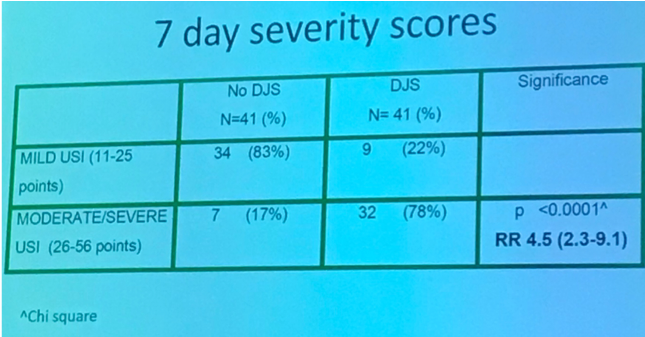The investigators divided a prospective cohort of 82 patients undergoing uncomplicated ureterolithotripsy into a postoperative DJS group and non-DJS group. LUTS were measured by the urinary symptom section of the Ureteral Stent Symptom Questionnaire (USSQ).
While there was no difference in complication rates between the groups, surgical time was significantly higher for the DJS group. There was a correlation between LUTS and the presence of DJS, and the primary predictor for LUTS was, indeed, the presence of DJS, even when adjusted for age, gender, BMI, stone density, and operative time. Dr. Herrera also reported that the DJS group had higher pain scores and that 78% of patients with a DJS had moderate or severe pain at postoperative day 7 (figure 1).

Figure 1. LUTS and pain scores at postoperative day 7.
The authors concluded that DJS placement following uncomplicated ureterolithotripsy is the main factor associated with moderate and severe LUTS based on USSQ. These findings beg the question, should placement of DJS be routine practice following an uncomplicated ureterolithotripsy? The consensus in the room was certainly that DJS placement should not be placed following uncomplicated ureterolithotripsy, as it is not in the best interest of the patient.
Presented by: Dr. Pedro Avila Herrera
Co-Authors: Jorge Moreno Palacios, Miguel González Domínguez
Author Affiliation: Urologist Hospital General CMN La Raza
Written by: Frank Jefferson, Department of Urology, University of California-Irvine, medical writer for UroToday.com at the 36th World Congress of Endourology (WCE) and SWL - September 20-23, 2018 Paris, France


